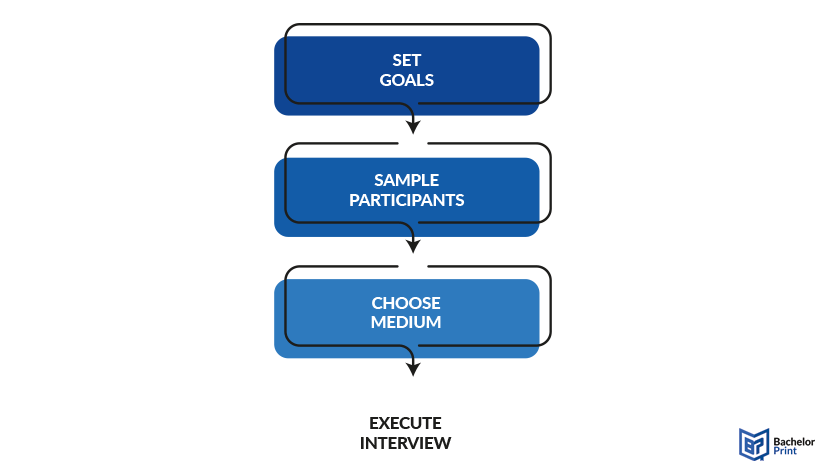
Hiring managers use different types of interviews to get qualified personnel. While the process can become time-consuming and nerve-racking, an unstructured format could make it fun and easier for the interviewers and interviewees. This article discusses the methodology of unstructured interviews, how to conduct such an interview, and what advantages and disadvantages it can have.
Definition: Unstructured interview
An unstructured interview, also known as a non-directive interview, is a form of interview that does not use a particular pattern and its questions are not predetermined. These interviews are often qualitative; hence, they are helpful in humanities and social science research aiming at personal experiences. Unstructured interviews thus serve as an excellent exploratory research tool.
How to conduct an unstructured interview
Proceed with the following four steps after determining that an unstructured interview is your best fit.
1. Set goals
First, you need to be clear about the topic because while you cannot set questions beforehand, you still need to plan your unstructured interview. Once you are sure about your research topic, brainstorm the categories of questions you may likely ask.
2. Sample participants
When assembling participants for your interview, there are three different approaches.
- One option is to look for random samples with flyers or an announcement online. This way you get a great variety of different people from different parts of society.
- Another way is to stratify samples. Here, you define a specific group of people you want to interview. This can be age, social status, financial background, etc.
- The easiest way to get samples is through convenience sampling, where you ask your fellow students, family or friends to answer your questions.
When sampling participants, you always need to be wary of sampling bias. This means that you instinctively chose similar people for your interview because maybe they seem the most approachable.
3. Choose the medium
Understand the advantages and disadvantages of using the different data collection mediums, as shown in the table below.
| Pro | Con | |
| On the phone | Participants may talk more open when they do not see the interviewer. | You cannot see your participant's expressions and behaviour. |
| Videochat | Participants are at home, in their comfortable environment. | If the connection to the internet is weak, you might miss important information. |
| In person | You can see their expressions and body language. | High risk of the interviewer effect. |
The interviewer effect describes the phenomenon, when participants feel the need to answer a question with something they think the interviewer would like to hear. This leads to untruthful answers and warps the results of the study.
When you need interview recordings for later transcriptions, always make sure to get written consent from your participants.
4. Execute the interview
Pay attention to conditions that may impact your interviews, like noise, body language, temperature, and setting. Keep your questions unbiased and natural, and ask open-ended questions to keep the conversation flowing. You should also avoid leading questions that imply a certain answer because of the interviewer effect.

Pros and cons of an unstructured interview
Unstructured interviews are very open and individual. While this can be a good thing to explore the subjective perspective of your participants, some cons also exist with this interview methodology.
The benefits of an unstructured interview are:
-
- Flexibility. Unstructured interviews are flexible and created like a normal conversation, fostering a friendly environment where new ideas and topics flow.
- Comfortable Structure. The open structure helps candidates feel more at ease, making it easier to discuss controversial or sensitive topics as misinterpretation can be reduced by further questions.
- More Detailed. Unstructured interviews explore the interviewees beliefs deeper, which can lead to new insights the interviewer may have not thought about.
The disadvantages of an unstructured interview are:
-
- Challenging to Monitor Questions. Since more questions may arise, it may lose the focus on your actual topic or lack crucial data by taking in too many other perspectives and aspects.
- Time-consuming. Unstructured interviews can consume much time for the interview and analysis. You may also take more time transcribing the information and thus conduct less interviews. The lack of enough samples may then reduce the quality of the study as a whole.
- Prone to Bias and leading questions. These interviews may sometimes tempt you to ask open-ended or leading questions, creating biases or predetermined answers. As the interviewer leads the conversation as they seem fit, it can end up very subjective.
- Hard to compare. Due to the individuality of each interview, it can be extremely hard to compare the results to one another.
Analyzing an unstructured interview
Assign your participants a pseudonym or number in the analysis stage before transcribing the recorded interviews. Conduct thematic or content analysis to create categories and find patterns within your responses.
Transcribing unstructured interviews
Transcribing unstructured questions can be lengthy because of excessive details. Therefore, you can choose intelligent transcription software programs.
- Intelligent verbatim transcription that includes filler words like “mmm,” hesitations, and laughter in your research.
- The intelligent verbatim transcription that excludes these fillers and saves time.
Transcribing helps cleanse your data before adding it to the appendix of your paper.
Coding unstructured interviews
Coding is the process of separating patterns, words, or repeated responses into categories for later analysis. Thematic analysis is ideal for unstructured questions to identify common ideas.
- After you’re satisfied with your responses, separate them into different labels or codes.
- Proceed by categorizing similar labels into broader themes.
- Double-check themes to ensure they appropriately represent your data.
The analysis
After coding, choose to either use a deductive or inductive analysis approach for the data of your unstructured interviews.
- An inductive approach is open-minded and allows all of your data to determine your themes, making it easier to find new approaches or related topics.
- A deductive approach is focused on your main question and goal, and thus investigates whether your data confirms the preconceived ideas or themes.
Thematic analysis may be subjective, leading to unreliability of your results, so always remain objective when analysing unstructured questions.
The results
After the data analysis, combine your results into a research paper that covers the following sections.
- Methodology: It describes the data collection process and explains how you conceptualize and justify your analysis.
- Discussion: It adds suggestions for future studies, since unstructured questions are exploratory. The section describes your coded labels and showcases your arguments.
- Conclusion: It finishes with your major takeaways and avenues for further research.
Types of interviews
No matter what your interview is for, you must research and choose the ideal form beforehand. The table below highlights the similarities and differences between an unstructured interview, a structured interview, and a semi-structured interview.
| Structured interviews | Semi-structured interviews | Unstructured interviews | |
| Fixed Questions | Yes | Yes | No |
| Fixed Order of Questions | Yes | No | No |
| Fixed Number of Questions | Yes | No | No |
| The Option to Ask Additional Questions | No | Yes | Yes |
FAQs
Unstructured interviews are ideal for exploring the perspective and emotions of the participant. They are flexible, interactive, and valid, making understanding and analysing the participants easier.
In an unstructured interview, there are no predetermined questions at all, while in a semi-structured interview, some questions are thought out beforehand. Both types of interviews have a more open approach that explore the perspectives and emotions of the interviewees, only that an unstructured interview is solely guided by the flow of the conversation.
The interviewer effect is a tendency of the participant to give answers, of which they think the interviewer would like to hear them. This, however, warps the results of the interview and thus of the study. Most often, the interviewer effect appears when the interview is conducted in person, for the literal closeness of the two people can have a strong effect on the interviewee.
Unstructured interviews are often used in social sciences when you want to research on human experiences and personal characteristics.
Since unstructured interviews are not structured, every participant might end up giving different answers to different questions. This makes it difficult to summarize the results and may also negatively influence the validity. Therefore, unstructured interviews are more suitable for general inquiries or to get an idea for direction in research, rather than proving a final result.
